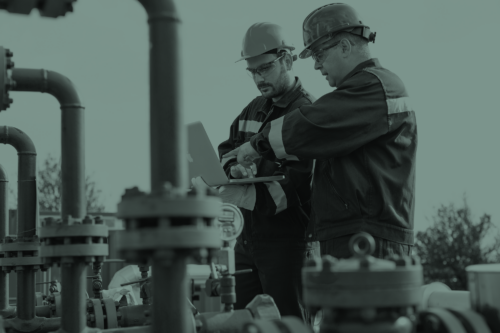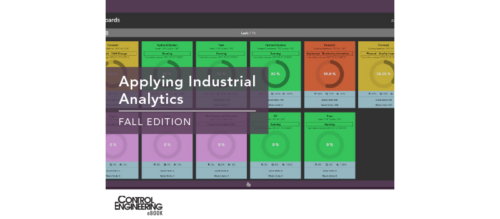Analytics
Analytics usually refers to software (usable code and algorithms) designed to examine trends and patterns often not otherwise visible to humans. Such software can operate by comparing existing operations to historical data sets. Such analysis can happen offline from a process or inline with process controls and automation and can send alarms or actuate changes if so enabled.
Analytics Articles
Using advanced analytics applications to improve sustainability
Case studies show how process manufacturers leverage data insights to proactively monitor key performance indicators (KPIs), reduce emissions and improve energy efficiency.
Learning Objectives
- Advanced analytics help manufacturers learn how everything operates and how efficient they can be.
- Advanced analytics applications help subject matter experts (SMEs) build models so they can better understand how process changes will improve environmental performance.
- Process manufacturers looking to improve sustainability can use assets that already exist within their facility.
Advanced Analytics Insights
- Process manufacturers are trying to improve sustainability and efficiency in their operations by focusing on key performance indicators (KPIs). Advanced analytics can help these companies get better and more precise insights into what does and doesn’t work.
- There is the temptation to start big, but that’s often not necessary. Starting small and building a proof of concept (PoC) can help lay the foundation for larger and more ambitious projects by giving stakeholders something tangible.
New data analytics tools delivered $600,000 savings in greenhouse gas emissions in 3 months at a refinery. A chemical manufacturer improved control methods to increase heat recovery 30% and cut steam consumption by 15% in 30 months. Sustainability has been recognized as an area of significant importance in the process industries over the last decade, with many process manufacturers publicly acknowledging concern for climate change and other environmental issues. In response to these and related concerns, these manufacturers are investing in personnel with a sole focus on leading sustainability efforts and creating concrete key performance indicators (KPIs).
 Figure 1: Process manufacturers can use environmental exceedance reports in Seeq to track cumulative emissions, and ensure regulatory compliance by remaining within acceptable limits. Courtesy: Seeq
Figure 1: Process manufacturers can use environmental exceedance reports in Seeq to track cumulative emissions, and ensure regulatory compliance by remaining within acceptable limits. Courtesy: Seeq
Progress toward KPIs provides benefits to process manufacturers, such as better access to capital for new investments, cost savings from reduced waste and lower energy consumption, and improved reputation—leading to a competitive advantage.
Yet, despite this focus, there is often a significant disconnect between words and actions because many process manufacturers still struggle to identify how to achieve their objectives with real measurable outcomes or improvements. And without a clear strategy in place, these well-intentioned goals are not awarded the required investment of time and resources.
With the right advanced analytics applications in their arsenal, process manufacturers can track environmental performance by optimizing use of existing assets, which will reveal opportunities to improve efficiencies, and thus sustainability.
Roadblocks on the path to sustainable industrial operations
The constantly evolving sustainability space includes growing regulatory, investor and social pressures, creating several challenges for process manufacturers. For starters, while sustainability in the process industries is often linked with newer technologies—such as carbon capture, alternative energy, and power storage—these initiatives are expensive to implement and maintain. Their benefits also are often not immediately realized.
For example, the carbon footprint associated with producing each wind turbine in a wind farm to capture wind energy must be paid back through operation. Considering the time required to design, build and implement a wind farm—and the required investment in power storage—process manufacturers will not realize the sustainability benefits for an extended period after implementation.
Measuring, decreasing industrial greenhouse gas emissions
These initial expenses and delayed benefits are compounded by a lack of reporting standardization and clear return on investment calculations, often leading to a lack of capital allocation. In fact, in the case of greenhouse gas (GHG) KPIs, the latest assessment from the Climate Action 100+ initiative found only 5% of companies were explicitly committed to aligning their CapEx plans with their long-term GHG reduction targets.
However, new regulatory actions could force process manufacturers to accelerate actions. In March of 2022, the Securities and Exchange Commission (SEC) proposed new rules that would require enhanced climate-related disclosures from public organizations, including information about direct GHG emissions (Scope 1), indirect emissions (Scope 2), and emissions from upstream and downstream activities in its value chain (Scope 3). Without insight into current operations, it becomes difficult for process manufacturers to make improvements, optimize operations and report on their environmental performance regardless of the GHG Scope.
With inadequate software, performing any sort of metric calculations becomes time consuming, resulting in valuable subject matter expert (SME) resources wasted on menial data management activities. In many cases, despite their time-consuming efforts, they still cannot gain enough insight into their environmental KPIS to drive improvements. With the right tools, designed specifically for analyzing time series process data, these teams can rapidly gain insights to inform near real-time process adjustments, leading to achievement of business objectives, while minimizing energy consumption and waste.
 Figure 2: A chemical manufacturer used Seeq to compare modeled and actual energy consumption. When a high deviation is identified, SMEs perform a root cause analysis. Courtesy: Seeq
Figure 2: A chemical manufacturer used Seeq to compare modeled and actual energy consumption. When a high deviation is identified, SMEs perform a root cause analysis. Courtesy: Seeq
Advancing toward environmental goals with analytics
When process manufacturers focus only on big ticket technologies to achieve their sustainability goals, they often overlook what they can do right now with existing resources to immediately optimize their environmental performance. Some of them require little to no capital investment. Process manufacturers collect time-series process data in historians for decades, and with advanced software tools in hand, they can immediately leverage this data to create a competitive advantage by empowering their employees to make sustainability a focus, and thus make progress toward goals.
Advanced analytics applications enable process manufacturers to gain more insight into their environmental process data, and then identify areas for improvement so they can optimize the environmental performance of existing assets. By expanding existing process improvement frameworks with flexibility and agility, these applications enable teams to master new and previously unsolvable sustainability use cases. Advanced analytics applications also enable process manufacturers to transition from a compliance-focused and reactive approach to a proactive, and even predictive, approach. By continuously monitoring parameters to detect issues, these organizations can assess performance to identify root causes.
In addition to monitoring and root cause analysis, advanced analytics applications help SMEs build models to better understand how process changes will improve environmental performance, for example, by using “what if” analyses. These models also can be applied to predict environmental performance and prevent excursions. The examples below show how advanced analytics applications can be used to improve efficiency and sustainability.
Excess flaring mitigation: $600,000 savings in 3 months
Flaring is a safety measure performed at many industrial plants and facilities—including refineries, chemical plants, oil rigs, and others—to prevent over-pressure events. However, flaring can also create its own problems. If the safety valves are faulty, this may cause lengthy periods of flaring, which wastes energy. The combustion system also may not work properly, causing the release of gas into the atmosphere, thus contributing to GHG emissions (Figure 1).
Most refineries have flaring systems to help them manage and account for these purge events. In the case of a large refinery in Canada, the process engineering team struggled to identify the targets or boundaries for flaring without the proper baseline, as operations changed over time. The team determined the periods of time when the equipment was on and at a high flow rate using value and deviation search functionalities. Using the signal from conditions function within the workbench, they determined the average flow rate as a baseline for the proper operation of the flare stack. With a live data connection to all its historical data, the team was empowered to proactively analyze more than 10 years of data in a short period of time, helping them identify and mitigate $600,000 worth of excess flaring in Q1 of 2022.
Reducing energy, water consumption: 30% improved heat recovery
A team of SMEs at a specialty chemical manufacturer created a multivariate model of their process energy consumption (Figure 2). This model was then used to compare expected (modelled) to actual energy consumption. Leveraging these comparisons and other investigations, the team determined that process issues, including a non-functioning valve and a poorly tuned controller, were causing significant energy waste.
Identifying the root cause of these deviations enabled the engineers to perform corrective actions and mitigate energy waste, increasing heat recovery by 30% and reducing steam consumption by 15% over the course of 30 months. The ongoing savings is the equivalent of removing 1,100 passenger vehicles from the road. Prior to developing energy models, these issues often went undetected.
Reducing emissions: Automation for compliance reporting
When process engineers at a refinery think about emissions, they are likely to focus on compliance, which often results in reacting to environmental excursions after the fact. However, with the right advanced analytics applications, these teams can shift to a proactive approach that enables them to contextualize data, gain key insights and perform root cause analysis (RCA).
 Figure 3: Advanced analytics applications can monitor and automatically report on emissions KPIs across an entire fleet of refineries. Courtesy: Seeq
Figure 3: Advanced analytics applications can monitor and automatically report on emissions KPIs across an entire fleet of refineries. Courtesy: Seeq
SMEs at an oil and gas company looked to automate their regulatory compliance reporting. The application connects to process historian data and applies calculations defined by SMEs to report emissions levels efficiently and accurately, in compliance with industry regulations (Figure 3). These reports are automatically updated as new data becomes available, saving the company two days of engineering time per report.
Using this available emissions performance data, the organization shifted from a reactive to a proactive approach for identifying issues and making mitigation process adjustments instead of acting after the fact.
Advanced analytic applications provide sustainability insights
While process manufacturers have an obligation to champion environmental efforts, achieving sustainable operations is a daunting task without a tangible action plan. These organizations should not overlook the opportunities they have to use existing assets and resources more efficiently to achieve improvements right away.
Armed with the right tools, teams can unlock more insight into environmental performance, empowering organizations to engage their employees at all levels so they can have a direct positive impact on a process manufacturer’s environmental footprint.
Mariana Sandin is an industry principal at Seeq Corp. Edited by Chris Vavra, web content manager, Control Engineering, CFE Media and Technology, cvavra@cfemedia.com.
ONLINE
See additional asset management stories at https://www.controleng.com/process-manufacturing/diagnostics-asset-management/
CONSIDER THIS
How are you using advanced analytics to improve your facility?
Analytics FAQ
-
What is the importance of analytics in manufacturing industry?
Analytics plays an important role in the manufacturing industry by enabling organizations to make data-driven decisions, which improve operational efficiencies and productivity.
Analytics provides real-time insights into production processes, supply chain performance, and other critical aspects of the manufacturing operations. This helps organizations make informed decisions and respond quickly to changes in the market or production environment.
-
What devices are used to collect data for analysis in manufacturing?
The specific devices used for data collection will vary depending on the needs of the manufacturing organization and the type of data being collected.
- Sensors: These devices are used to measure and monitor physical characteristics of production processes, such as temperature, pressure and vibration. The data collected by sensors can provide real-time insights into the performance of equipment and processes.
- Production systems: These systems, such as computer numerical control (CNC) machines and automated assembly lines, generate data on production processes and output.
- Enterprise resource planning (ERP) systems: These systems collect and store data on a variety of manufacturing operations, including production planning, supply chain management and financial accounting.
- Internet of things (IoT) devices: These devices can be used to gather data from sensors and other sources and transmit it to central data storage and analysis systems.
- Barcode scanners: These devices can be used to track the movement of goods and materials through the supply chain, providing data on inventory levels, shipping times and other key metrics.
-
What does a manufacturing data analyst do?
A manufacturing data analyst plays a critical role in helping organizations make data-driven decisions and drive improvements in manufacturing operations through the use of data analytics and technology. Manufacturing data analysts are responsible for collecting, analyzing, and interpreting data to support decision-making and drive improvements in manufacturing operations.
-
What does big data refer to in manufacturing?
Big data in manufacturing refers to the large and complex sets of data generated by production processes, supply chain operations, and other activities within the manufacturing industry. This data can include information from sensors, production systems, enterprise resource planning (ERP) systems, and other sources. The volume, velocity, and variety of this data makes it difficult to process and analyze using traditional methods.
Big data analytics in manufacturing leverages advanced technologies such as distributed computing, machine learning and data visualization to process, analyze, and make sense of this data. The goal is to extract valuable insights that can be used to improve operational efficiency, increase productivity, and make data-driven decisions. This can include identifying trends and patterns, predicting equipment failure, optimizing production processes, and improving supply chain performance, among other applications.
Some FAQ content was compiled with the assistance of ChatGPT. Due to the limitations of AI tools, all content was edited and reviewed by our content team.











